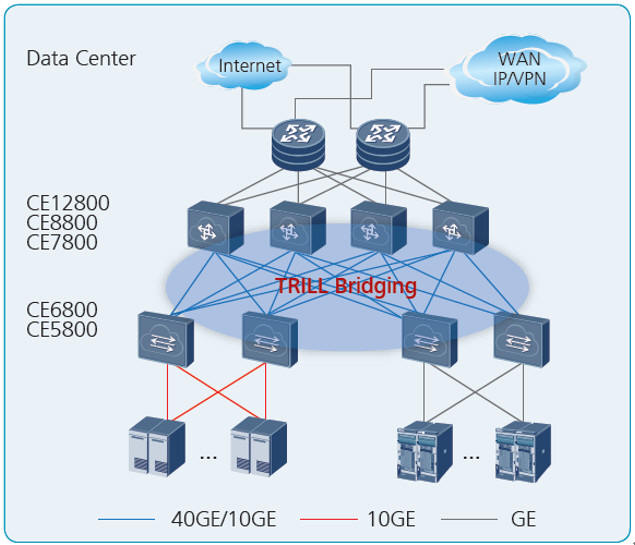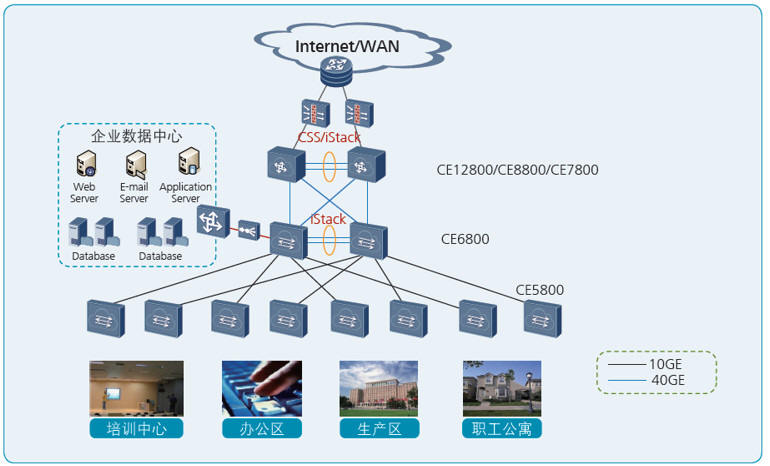Huawei CloudEngine 8800 series (CE8800) switches are 40G Ethernet
switches designed for data centers and high-end campus networks. The
switches provide high-performance, high-density 40 GE ports, and low
latency. The CE8800 hardware has an advanced architectural design
with 100 GE/40 GE/25 GE/10 GE ports. Using the Huawei VRP8 software
platform, CE8800 switches provide extensive data center service
features and high stacking capability. In addition, the airflow
direction (front-to-back or back-to-front) can be changed. CE8800
switches can work with CE12800/CE8800/CE6800/CE5800 switches to
build an elastic, virtualized, high-quality fabric for
cloud-computing data centers.
CE8800 switches can function as core or aggregation switches on data
center networks to help enterprises and carriers build a scalable
data center network platform in the cloud computing era. They can
also be used as aggregation or core switches for enterprise campus
networks.
| Model and appearance | Description |
|---|---|
 CE8860-4C-EI |
|
| Model and appearance | Description |
|---|---|
 CE88-D24S2CQ |
|
 CE88-D24T2CQ |
|
 CE88-D8CQ |
|
 CE88-D16Q |
|
| Item | CE8860-4C-EI |
|---|---|
| Ports |
4 slots, different cards can be flexibly used in combinations to achieve a maximum of: 32 x 100 GE QSFP28 or 64 x 40 GE QSFP+ or 128 x 25 GE SFP28 or 128 x 10 GE SFP+ ports |
| Switching Capacity | 2.56 Tbit/s |
| Forwarding Performance | 2,976 Mpps |
| Airflow Design | Front-to-back or back-to-front |
| Device Virtualization | iStack |
| Network Virtualization | M-LAG |
| TRILL | |
| VXLAN routing and bridging | |
| EVPN | |
| VM-awareness | Agile Controller |
| Network Convergence | FCoE |
| DCBX, PFC, ETS | |
| Programmability | openflow |
| ENP | |
| OPS | |
| openflow, Puppet, and Ovsdb plugins released on open source websites | |
| Linux container for open source and customization programming | |
| Traffic Analysis | NetStream |
| sFlow | |
| VLAN | Adding access, trunk, and hybrid interfaces to VLANs |
| Default VLAN | |
| QinQ | |
| MUX VLAN | |
| MAC Address Table | Dynamic learning and aging of MAC addresses |
| Static, dynamic, and black hole MAC address entries | |
| Packet filtering based on source MAC addresses | |
| MAC address limiting based on ports and VLANs | |
| IP Routing | IPv4 routing protocols, such as RIP, OSPF, BGP, and IS-IS |
| IPv6 routing protocols, such as RIPng, OSPFv3, IS-ISv6, and BGP4+ | |
| IPv6 | IPv6 Neighbor Discovery (ND) |
| Path MTU Discovery (PMTU) | |
| TCP6, ping IPv6, tracert IPv6, socket IPv6, UDP6, and Raw IP6 | |
| Multicast | IGMP, PIM-SM, PIM-DM, MSDP, and MBGP |
| IGMP snooping | |
| IGMP proxy | |
| Fast leave of multicast member interfaces | |
| Multicast traffic suppression | |
| Multicast VLAN | |
| MPLS | MPLS |
| Reliability | LACP |
| STP, RSTP, MSTP, and VBST | |
| BPDU protection, root protection, and loop protection | |
| Smart Link and multi-instance | |
| DLDP | |
| ERPS (G.8032) | |
| VRRP, VRRP load balancing, and BFD for VRRP | |
| BFD for BGP/IS-IS/OSPF/Static route | |
| QoS | Traffic classification based on Layer 2 headers, Layer 3 protocols, Layer 4 protocols, and 802.1p priority |
| Actions of ACL, CAR, re-marking, and scheduling | |
| Queue scheduling algorithms, including PQ, WRR, DRR, PQ + WRR, and PQ + DRR | |
| Congestion avoidance mechanisms, including WRED and tail drop | |
| Traffic shaping | |
| Configuration and Maintenance | Console, Telnet, and SSH terminals |
| Network management protocols, such as SNMPv1/v2c/v3 | |
| File upload and download through FTP and TFTP | |
| BootROM upgrade and remote upgrade | |
| 802.3az Energy Efficient Ethernet (EEE) | |
| Hot patches | |
| User operation logs | |
| Zero-Touch Provisioning (ZTP) | |
| Security and Management | 802.1x authentication |
| Command line authority control based on user levels, preventing unauthorized users from using commands | |
| DoS, ARP, and ICMP attack defenses | |
| Port isolation, port security, and sticky MAC | |
| Binding of the IP address, MAC address, interface and VLAN | |
| Authentication methods, including AAA, RADIUS, and HWTACACS | |
| Remote Network Monitoring (RMON) | |
| Dimensions (W x D x H) | 442 mm x 600 mm x 88.1 mm |
| Weight (fully loaded) | 27 kg |
| Environment Parameters |
Operating temperature: 32oF to 104oF at 0 ft. to 5,905.5 ft. (0°C to 40°C at 0m to 1,800m) Storage temperature: -40oF to 158oF (-40°C to 70°C) Relative humidity: 5% to 95% (non-condensing) |
| Operating Voltage |
Rated voltage: 100V AC to 240V AC, 50 Hz to 60 Hz Maximum voltage: 90V DC to 290V AC, 47 Hz to 63 Hz 240V high-voltage DC power voltage: 188V to 290V DC 380V high-voltage DC rated voltage: 240V to 380V DC 380V high-voltage DC maximum voltage: 188V to 400V DC |
| Maximum Power Consumption | 800W (theoretical) |
Note: The TRILL protocol can be also used on campus networks to support flexible service deployments in different service areas.


| Mainframe | |
|---|---|
| CE8860-4C-EI-F | CE8860-4C-EI switch (4 subcard slots with airflow from the fan module panel to the front panel (with ports and without power module)) |
| CE8860-4C-EI-B | CE8860-4C-EI switch (4 slots with airflow from the front panel (with ports) to the fan module panel, without power module) |
| Subcard | |
| CE88-D8CQ | 8-port, 100G Ethernet optical (QSFP28) |
| CE88-D16Q | 16-port, 40G Ethernet optical (QSFP+) |
| CE88-D24T2CQ | 24-port, 10G Ethernet electrical (RJ45) and 2-port 100G Ethernet optical (QSFP28) |
| CE88-D24S2CQ | 24-port, 10G Ethernet optical (SFP+) and 2-port 100G Ethernet optical (QSFP28) |
| Power module | |
| PAC-1K2WA-F | 1,200W AC and 240V DC power module with airflow from the power module panel to the front panel (with ports) |
| PAC-1K2WA-B | 1,200W AC and 240V DC power module, with airflow from the front panel (with ports) to the power module panel |
| PHD-1K2WA-F | 1,200W high-voltage DC power module with airflow from the power module panel to the front panel (with ports) |
| PHD-1K2WA-B | 1,200W high-voltage DC power module with airflow from the front panel (with ports) to the power module panel |